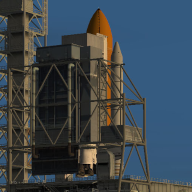n72.75
Move slow and try not to break too much.
Orbiter Contributor
Addon Developer
Tutorial Publisher
Donator
- Joined
- Mar 21, 2008
- Messages
- 2,696
- Reaction score
- 1,353
- Points
- 128
- Location
- Saco, ME
- Website
- mwhume.space
- Preferred Pronouns
- he/him
The major roadblock to OpenOrbiter 64bit stability is a lack of source code for some of the celestial bodies (mostly moons of Uranus and Mars).
In past Orbiter releases, these were always packaged as just a DLL and I'm not sure Dr. Martin S. ever had the source, at least it was never added to GitHub; to the best of my knowledge these were created prior to Orbiter 2006 by a forum (M6) user.
This was noted here:
 www.orbiter-forum.com
www.orbiter-forum.com
And we have a Github issue for the effect that it causes in 64bit builds: If you want to see what injecting NaN's into the propagator looks like...

 github.com
github.com
If we want stable x64 builds (and we will need them at some point, if we want development to continue) we have several options:
Of these three options, #3 is by far the best, and while this may at first seem like a tremendous undertaking, a huge amount of work has already gone into implementing it.
While testing my tesseral gravity project (which I also need to revisit) I used this SPICE/DE440 which brings with it a whole host of improvements to ephemerides accuracy and rotational position.
The only real downside I can see is that SPICE kernels can get rather large (1960 to 2050 is 600MB), but on the other hand most of us have 55+ GB of planetary textures laying around, so that's not bad. How we handle this on Github is another story.
I am making this thread because of a discussion that @Ajaja and @Boxx . This can serve as a discussion jumping-off-point, and we can also discuss on Discord. At the moment, I am looking for some feedback from the community.
In past Orbiter releases, these were always packaged as just a DLL and I'm not sure Dr. Martin S. ever had the source, at least it was never added to GitHub; to the best of my knowledge these were created prior to Orbiter 2006 by a forum (M6) user.
This was noted here:
Celbody modules with no source code
Hi, I'm having NaN (as in Not A Number) issues related to celbodies with binary only modules (Deimos, Phobos...). I tried to patch their config files but it turned out I made a mess of it... Anyway, is there a reason for not having the source code for these? (licensing issues, code lost, or...
 www.orbiter-forum.com
www.orbiter-forum.com
And we have a Github issue for the effect that it causes in 64bit builds: If you want to see what injecting NaN's into the propagator looks like...
Physics Instability Caused by 32 bit DLLs · Issue #243 · orbitersim/orbiter
This issue is most noticeable when taking off from Mars in some of the default Delta Glider or Shuttle A scenarios. Reference: Piraxus/OrbiterSkyboltClient#8 I have noted similar issues randomly ta...
If we want stable x64 builds (and we will need them at some point, if we want development to continue) we have several options:
- Delete the offending moons from the default Sol system.
- Hope the original author of these modules returns at some point and blesses us with the source code.
- Replace the modules entirely.
Of these three options, #3 is by far the best, and while this may at first seem like a tremendous undertaking, a huge amount of work has already gone into implementing it.
While testing my tesseral gravity project (which I also need to revisit) I used this SPICE/DE440 which brings with it a whole host of improvements to ephemerides accuracy and rotational position.
The only real downside I can see is that SPICE kernels can get rather large (1960 to 2050 is 600MB), but on the other hand most of us have 55+ GB of planetary textures laying around, so that's not bad. How we handle this on Github is another story.
I am making this thread because of a discussion that @Ajaja and @Boxx . This can serve as a discussion jumping-off-point, and we can also discuss on Discord. At the moment, I am looking for some feedback from the community.


